Best EMA Indicator Tools to Buy in January 2026
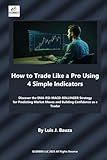
How to Trade Like a Pro Using 4 Simple Indicators: Discover the EMA-RSI-MACD-BOLLINGER Strategy for Predicting Market Moves and Building Confidence as a Trader



Mastering Exponential Moving Averages for beginners by Lalit Mohanty (Learn Stock Market Trading)


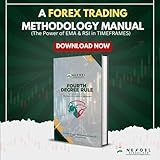
THE FOURTH DEGREE RULE METHODOLOGY: The Power of EMA and RSI in Timeframes


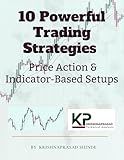
10 Powerful Trading Strategies: Price Action & Indicator - based Setups


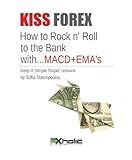
KISS FOREX : How to Rock n' Roll to the Bank with...MACD+EMA's | Keep It Simple Stupid Lessons (FXHOLIC Book 5)


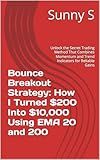
Bounce Breakout Strategy: How I Turned $200 Into $10,000 Using EMA 20 and 200: Unlock the Secret Trading Method That Combines Momentum and Trend Indicators for Reliable Gains


The Exponential Moving Average (EMA) is a popular technical analysis indicator used by traders to analyze and predict price trends. It is considered a versatile tool that provides a more weighted view of recent price action compared to other moving averages.
Unlike the simple moving average (SMA), which gives equal weight to each price point in the calculation, the EMA assigns more weight to recent data points. This weighting is achieved by applying a smoothing factor to the previous EMA value, emphasizing the most recent prices more significantly.
EMA calculations involve the following steps:
- Select a time period: Determine the time frame over which you want to analyze the data. Common choices include 10, 20, 50, or 200 periods, but it can be adjusted to suit your trading style.
- Calculate the multiplier: Use the formula 2 ÷ (selected time period + 1) to find the multiplier. For example, if a 10-period EMA is being calculated, the multiplier will be 2 ÷ (10 + 1) = 0.1818.
- Calculate the initial EMA: To start, you need a simple moving average for the selected time period. This can be obtained by adding up the closing prices for the number of periods and dividing by that number.
- Calculate subsequent EMAs: For each subsequent data point, apply the following formula: EMA = (Closing price - Previous EMA) × Multiplier + Previous EMA Where "Closing price" is the latest price point, "Previous EMA" is the EMA value of the previous day, and "Multiplier" is the calculated multiplier. The resulting EMA is then used as the previous EMA for the calculation of the next data point.
Interpretation of EMAs:
- Identifying trend direction: Traders use EMAs to determine the general trend. When the price is above the EMA, it suggests an uptrend, whereas when it is below, it indicates a downtrend.
- Generating trading signals: Traders often consider two EMAs of different periods, such as a shorter and longer EMA. When the shorter EMA crosses above the longer EMA, it generates a bullish signal, and when it crosses below, it generates a bearish signal.
- Identifying support and resistance levels: EMAs can act as dynamic support or resistance levels. When the price bounces off the EMA, it can indicate a potential reversal or a continuation of the trend, depending on the context.
EMA is a powerful tool for technical analysis, but like any indicator, it is not foolproof. It is advisable to combine it with other tools and indicators to confirm signals and make informed trading decisions.
How to use Exponential Moving Average (EMA) for risk management?
Exponential Moving Average (EMA) can be used as a risk management tool by traders and investors to identify potential price reversals and manage their risk exposure. Here are a few ways to use EMA for risk management:
- Trend Identification: EMA helps in identifying the direction of the trend by plotting a line that smoothens out the price fluctuations. By comparing the current price with the EMA line, traders can determine if the market is in an uptrend or downtrend. This information helps them assess the risk associated with trade entries and exits.
- Entry and Exit Points: EMA crossovers are commonly used to find optimal entry and exit points. When the shorter-term EMA (e.g., 20-day EMA) crosses above the longer-term EMA (e.g., 50-day EMA), it generates a buy signal. Conversely, when the shorter-term EMA crosses below the longer-term EMA, it generates a sell signal. These crossover points can be used to enter or exit positions, aiding in risk management by providing entry and exit signals.
- Stop Loss Placement: EMA can help determine appropriate stop loss levels. Traders often place stop loss orders just below or above the EMA line, depending on their positioning. By using the EMA as a trailing stop, traders can protect their profits or limit their losses, thereby managing their risk exposure.
- Volatility Adjustments: EMA can be adjusted to various time frames based on the trader's risk tolerance. Shorter time frame EMAs (e.g., 8-day or 14-day) are more responsive to price fluctuations and can be useful for identifying short-term trends and managing risk in volatile markets. On the other hand, longer time frame EMAs (e.g., 100-day or 200-day) smooth out the price movement, offering a broader perspective on the market trend and managing risk in less volatile markets.
- Confirmation Tool: EMA can act as a confirmation tool when used in conjunction with other technical indicators or chart patterns. This helps mitigate the risk of false signals. For example, if a reversal candlestick pattern occurs around the EMA line, it can provide additional confirmation for potential trend changes, allowing traders to adjust their risk accordingly.
Remember, risk management is a combination of various factors, and the EMA is just one tool among many. It is advisable to use EMA in conjunction with other risk management tools, technical indicators, and fundamental analysis for a comprehensive risk management strategy.
What is the relationship between Exponential Moving Average (EMA) and price momentum?
The Exponential Moving Average (EMA) is a technical indicator used in financial analysis to smooth out price data. It is calculated by giving more weight to recent prices compared to older prices. Price momentum, on the other hand, refers to the rate at which the price of an asset is changing.
The relationship between EMA and price momentum is that the EMA can be used to gauge the strength and direction of price momentum. When the price of an asset is trending strongly in one direction, the EMA will effectively track and reflect this momentum. As the EMA gives more weight to recent prices, it responds more quickly to changes in price momentum compared to other moving average indicators.
By looking at the slope and direction of the EMA, traders and analysts can gain insights into the strength and direction of price momentum. A strong upward slope in the EMA suggests positive price momentum, while a downward slope indicates negative price momentum. Traders often interpret an upward crossover of the EMA as a buy signal indicating a potential increase in price momentum, and a downward crossover as a sell signal suggesting a decline in price momentum.
In summary, the EMA is a tool that can help identify and track price momentum, providing insights into the current trend and potential future movements in an asset's price.
What are the advantages of using Exponential Moving Average (EMA) over other moving averages?
There are several advantages of using Exponential Moving Average (EMA) over other types of moving averages:
- More responsive to recent price changes: EMA assigns more weight to recent data points, making it more responsive to short-term price movements. This can be beneficial for traders and investors who want to react quickly to changes in market conditions.
- Smooths out noise and reduces lag: EMA calculations are based on a smoother and more continuous calculation process. As a result, it reduces the impact of noise and provides a more accurate representation of the underlying trend. EMA is less likely to lag behind significant price moves compared to other moving averages.
- Flexible and adaptable: EMA can be adjusted based on the preferred time period and sensitivity to price changes. Traders can easily customize the EMA based on their trading strategies and timeframes. This flexibility makes EMA a versatile tool for various trading styles and market conditions.
- More suitable for trend following: Due to its responsiveness and reduced lag, EMA is often preferred by trend-following traders. It allows them to capture trends more quickly and efficiently, enabling timely entry and exit points in the market.
- Widely used in technical analysis: Many traders and analysts rely on EMA as a key indicator in technical analysis. Therefore, it has become widely recognized and understood by market participants. As a result, EMA signals often attract attention from a large number of traders, potentially influencing market behavior.
Overall, the advantages of EMA make it a popular choice among traders and investors who seek a moving average that can provide a more accurate representation of short-term price movements.
What are the characteristics of a strong Exponential Moving Average (EMA) trend?
A strong Exponential Moving Average (EMA) trend exhibits the following characteristics:
- Steep slope: The EMA line moves in a consistent and steep upward or downward direction, indicating a strong and sustained trend.
- Smooth curve: The EMA line follows a smooth curve, with limited fluctuations or counter-trend movements.
- Respect for the EMA line: The price consistently respects and stays close to the EMA line without significant deviations or pullbacks.
- Higher highs (uptrend) or lower lows (downtrend): In an uptrend, each successive peak is higher than the previous one, demonstrating the strength of the upward movement. Conversely, in a downtrend, each successive trough is lower than the previous one, indicating a strong downward momentum.
- Minimal crossovers: During a strong EMA trend, there are minimal crossovers between the price and the EMA line. This suggests that the trend is well-established and less prone to reversals or short-term fluctuations.
- Volume confirmation: A strong EMA trend is typically accompanied by higher trading volume, indicating the participation of a large number of traders and reinforcing the strength and validity of the trend.
- Extended time frame: A strong EMA trend persists over an extended period, indicating that the market sentiment is favoring the trend direction consistently.
It is worth noting that these characteristics are not set in stone, and the strength of an EMA trend can vary depending on market conditions, time frame, and other factors.
How to calculate Exponential Moving Average (EMA) using a spreadsheet?
To calculate the Exponential Moving Average (EMA) using a spreadsheet, you can follow these steps:
- Determine the length of the moving average period. For example, if you want to calculate a 10-day EMA, the period would be 10.
- Create a column in your spreadsheet to input the closing prices of the asset or data you want to calculate the EMA for. Let's assume this column is column A and the first data point is in cell A2.
- In the next column, let's say column B, enter the formula to calculate the EMA for the first period. This can be done using the following formula: "=IF(ROW()≤[period],AVERAGE($A$2:A2),EMA[last_period]+([alpha]×(AVERAGE($A$2:A2)-EMA[last_period])))", where [period] represents the length of the moving average period, [alpha] is the smoothing factor derived from the length of the period [(2÷[period]+1)], and EMA[last_period] is the EMA value for the previous period.
- Drag this formula down the column to calculate the EMA for the rest of the periods. The formula will automatically adjust for each row, updating the average and previous EMA values accordingly.
- The final column will now contain the EMA values for each period.
Note: Some spreadsheet programs may have a built-in function to calculate the EMA, such as "=EMA(range, period)", where "range" represents the data range to calculate the EMA for and "period" is the length of the moving average period. Check the documentation or functions library of your spreadsheet software to see if this function is available.
